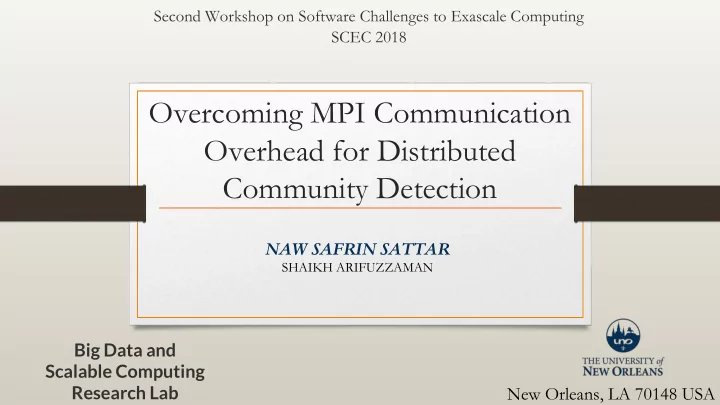

Second Workshop on Software Challenges to Exascale Computing SCEC 2018 Overcoming MPI Communication Overhead for Distributed Community Detection NAW SAFRIN SATTAR SHAIKH ARIFUZZAMAN Big Data and Scalable Computing Research Lab New Orleans, LA 70148 USA
Introduction • Louvain algorithm –A well-known and efficient method for detecting communities • Community –a subset of nodes having more inside connections than outside Big Data and Scalable Computing Research Lab 2
Motivation • Community Detection Challenges – Large networks emerging from online social media • Facebook • Twitter – Other scientific disciplines • Sociology • Biology • Information & technology • Load balancing – Minimize communication overhead – Reduce idle times of processors leading to increased speedup Big Data and Scalable Computing Research Lab 3
Parallelization Challenges Shared Memory Distributed Memory • Merits • Merits – Conventional multi-core – utilize a large number of processors processing nodes • Demerits – freedom of communication among processing nodes – Scalability limited by moderate through passing messages no. of available cores • Demerits – Physical cores limited for the scalable chip size restriction – An efficient communication scheme required – Shared global address space size limited for memory constraint Big Data and Scalable Computing Research Lab 4
Louvain Algorithm • Big Data and Scalable Computing Research Lab 5
Louvain Algorithm ❑ 2 Phases ➢ Modularity Optimization- looking for "small" communities by local optimization of modularity ➢ Community Aggregation- aggregating nodes of the same community a new network is built with the communities as nodes Big Data and Scalable Computing Research Lab 6
Shared Memory Parallel Algorithm • Parallelize computational task-wise –iterate over the full network –the neighbors of a node • Work done by multiple threads –minimize the workload –do the computation faster Big Data and Scalable Computing Research Lab 7
Distributed Memory Parallel Algorithm Big Data and Scalable Computing Research Lab 8
Hybrid Parallel Algorithm • Both MPI and OpenMP together • Flexibility to balance between both shared and distributed memory system ❑ Challenge ➢ Demerits of Distributed Memory Overweigh the performance Big Data and Scalable Computing Research Lab 9
DPLAL- Distributed Parallel Louvain Algorithm with Load-balancing • Similar approach as Distributed Memory Parallel Algorithm • Load balancing of Input Graph using Graph-partitioner METIS • Re-computation required for each function being calculated from Input Graph Big Data and Scalable Computing Research Lab 10
Experimental Setup • Language – C++ • Libraries – Open Multi-Processing (OpenMP) – Message Passing Interface (MPI) – METIS • Environment – Louisiana Optical Network Infrastructure (LONI) QB2 compute cluster • 1.5 Petaflop peak performance • 504 compute nodes • over 10,000 Intel Xeon processing cores of 2.8 GHz Big Data and Scalable Computing Research Lab 11
Dataset Network Vertices Edges Description Email network from a large email-Eu-core 1,005 25,571 European research institution Social circles (’friends lists’) ego-Facebook 4,039 88,234 from Facebook wiki-Vote 7,115 1,03,689 Wikipedia who-votes-on-whom network 6,301 20,777 A sequence of snapshots of the Gnutella peer-to-peer p2p-Gnutella08, 09, - - file sharing network for different dates of August 04, 25, 30, 31 62,586 1,47,892 2002 soc-Slashdot0922 82,168 9,48,464 Slashdot social network from February 2009 com-DBLP 3,17,080 10,49,866 DBLP collaboration(co-authorship) network roadNet-PA 1,088,092 1,541,898 Pennsylvania road network Big Data and Scalable Computing Research Lab 12
Speedup Factors of Parallel Louvain Algorithms Big Data and Scalable Computing Research Lab 13
Speedup Factor of DPLAL-Distributed Parallel Louvain Algorithm with Load Balancing Big Data and Scalable Computing Research Lab 14
Runtime Analysis of RoadNet-PA Graph with DPLAL algorithm Big Data and Scalable Computing Research Lab 15
Runtime of DPLAL Algorithm with Increasing Network Sizes Big Data and Scalable Computing Research Lab 16
Comparison of METIS Partitioning Approaches Big Data and Scalable Computing Research Lab 17
Performance Analysis Sequential Algorithm Another MPI based Parallel Algorithm DPLAL Charith et.al Network (node) size – Speedup 317,080 – 12, almost double 500,000 - 6 Speedup for the largest network 4 (1M nodes), same 4 (8M nodes) Scalability for Processors Upto 1000 Upto 16 Big Data and Scalable Computing Research Lab 18
Conclusion • Our parallel algorithms for Louvain method demonstrating good speedup on several types of real-world graphs • Implementation of Hybrid Parallel Algorithm to tune between shared and distributed memory depending on available resources • Identi fi cation of the problems for the parallel implementations • An optimized implementation DPLAL –DBLP network 12-fold speedup. –Our largest network, roadNetwork-PA 4-fold speedup for same number of processors Big Data and Scalable Computing Research Lab 19
Future Works • Improve the scalability of our algorithm for large scale graphs with billions of vertices and edges – other load balancing schemes to find an e ffi cient load balancing • Eliminate the effect of small communities hindering the detection of meaningful medium sized communities • Investigate the effect of node ordering on the performance – degree based ordering – kcores – clustering coefficients Big Data and Scalable Computing Research Lab 20
Contact: nsattar@uno.edu Big Data and Scalable Computing Research Lab 21
Recommend
More recommend